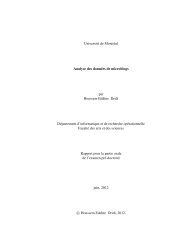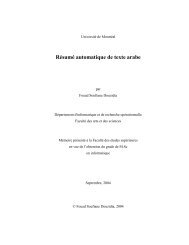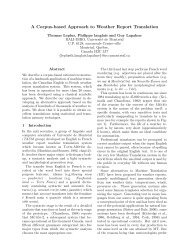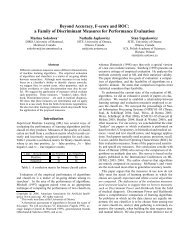Designing a Machine Translation System for Canadian Weather ...
Designing a Machine Translation System for Canadian Weather ...
Designing a Machine Translation System for Canadian Weather ...
You also want an ePaper? Increase the reach of your titles
YUMPU automatically turns print PDFs into web optimized ePapers that Google loves.
<strong>Designing</strong> a <strong>Weather</strong> Warning <strong>Translation</strong> <strong>System</strong> 14<br />
sively of sentence pairs drawn from weather warnings. The training corpus is the<br />
only subcorpus containing text from <strong>for</strong>ecasts, in addition to weather warning text.<br />
Moreover, to avoid any overlap between on the one hand, the training corpus,<br />
and on the other hand, the tune and test corpora, the training corpus excludes<br />
all warnings issued during the winter of 2010 and the summer/fall of 2011. From<br />
the warnings issued during these periods were drawn 400 warnings <strong>for</strong> tuning and<br />
400 others <strong>for</strong> testing. It is noteworthy that the time periods covered by the test<br />
and tune corpora include the summer months during which most of the weather<br />
warnings are issued.<br />
We chose to make these two corpora as “hard” to translate as possible by picking<br />
warnings that contained at least one word or sentence unknown to the training<br />
corpus. We did this <strong>for</strong> two reasons. First, we wanted our test and tune corpora<br />
to reflect the appearance of new words and phrasings over time. Secondly, the<br />
SMT engine is destined to be augmented by a translation memory (Section 4.3),<br />
which would take care of translating previously encountered sentences. This bias<br />
we introduced in favor of unseen words and sentences can be indirectly observed<br />
through the ratio of unique French sentences over unique English sentences, in<br />
Table 2. While in the training corpus this ratio is 558,996/523,305 ≈ 1.067, it falls to<br />
approximately 1.0 <strong>for</strong> the test and tune corpora. In other words, the training corpus<br />
contains numerous English sentences <strong>for</strong> which there is more than one possible<br />
French equivalent, whereas this is significantly less important in the train and test<br />
corpora. An example of this one-to-many mapping is shown in Table 3.<br />
The corpus’s sentences are quite short: 8.4 tokens on average <strong>for</strong> English and<br />
10.2 tokens <strong>for</strong> French. On average, a weather warning bulletin contains a discussion<br />
that is 5.8 sentences long. On average, each sentence is found 9.1 times in the corpus,<br />
a figure that shows the highly repetitive nature of this type of text.<br />
The vocabulary is very limited and consists <strong>for</strong> the training corpus of a mere 14.5k<br />
types <strong>for</strong> English and 18.7k types <strong>for</strong> the morphologically richer French version. As<br />
mentioned in Section 4.4.1, a small but non-negligible percentage of those types are<br />
typographical errors. The out-of-vocabulary (OOV) tokens account <strong>for</strong> 0.2% of the<br />
French test corpus and 0.3% of the English test corpus, a very low figure.<br />
The complete corpus, consisting of all of the <strong>for</strong>ecasts and warnings at our disposal,<br />
was used to retrain the machine translation engine be<strong>for</strong>e its deployment in<br />
a production environment. This corpus (last line in Table 1) is not merely the concatenation<br />
of the train, tune and test corpora: it also includes all warnings from the<br />
winter of 2010 and the summer/fall of 2011, which were not among the 800 selected<br />
<strong>for</strong> the tune and test corpora.<br />
5 <strong>Designing</strong> an SMT module<br />
Being in the enviable position that we had quite a lot of in-domain bilingual data, we<br />
decided to make the system as simple as possible. We thus decided to use standard<br />
tools <strong>for</strong> developing the translator and simple methods to filter out the phrase table.<br />
We trained a phrase-based statistical translation engine <strong>for</strong> each translation direction<br />
using the Moses toolkit and decoder (Koehn et al. 2007), subversion repository











